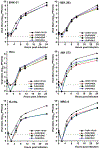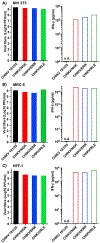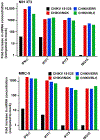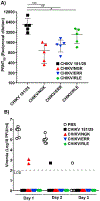Lack of nsP2-specific nuclear functions attenuates chikungunya virus replication both in vitro and in vivo
- PMID: 31163352
- PMCID: PMC7204530
- DOI: 10.1016/j.virol.2019.05.016
Lack of nsP2-specific nuclear functions attenuates chikungunya virus replication both in vitro and in vivo
Abstract
Chikungunya virus (CHIKV) is an important arthritogenic human pathogen that is already circulating in both hemispheres. In the present study, we substituted VLoop, located on the surface of nsP2, by other amino acid sequences. These modifications had deleterious effects on viral nuclear functions and made CHIKV incapable of interfering with the induction of type I interferon and the antiviral response in both mouse and human cells. Importantly, the identified mutations have no significant effects on the synthesis of virus-specific RNAs and viral structural proteins. The designed mutants induced a few orders of magnitude lower viremia but remained highly immunogenic in mice. Thus, the proposed modifications of nsP2 can additionally improve the safety of the attenuated strain CHIKV 181/25. Furthermore, defined mutations in the macro domain of another nonstructural protein, nsP3, additionally reduce cytopathogenicity of nsP2 mutants in human cells, and can be potentially applied for CHIKV attenuation.
Keywords: Alphaviruses; Chikungunya virus; Cytopathic effect; Transcription inhibition; Vaccines; Viral RNA replication; Virus-host interaction; nsP2; nsP3.
Copyright © 2019. Published by Elsevier Inc.
Figures










Similar articles
-
Novel Mutations in nsP2 Abolish Chikungunya Virus-Induced Transcriptional Shutoff and Make the Virus Less Cytopathic without Affecting Its Replication Rates.J Virol. 2019 Feb 5;93(4):e02062-18. doi: 10.1128/JVI.02062-18. Print 2019 Feb 15. J Virol. 2019. PMID: 30487275 Free PMC article.
-
Mutations conferring a noncytotoxic phenotype on chikungunya virus replicons compromise enzymatic properties of nonstructural protein 2.J Virol. 2015 Mar;89(6):3145-62. doi: 10.1128/JVI.03213-14. Epub 2014 Dec 31. J Virol. 2015. PMID: 25552719 Free PMC article.
-
YBX1 is required for assembly of viral replication complexes of chikungunya virus and replication of multiple alphaviruses.J Virol. 2025 Feb 25;99(2):e0201524. doi: 10.1128/jvi.02015-24. Epub 2024 Dec 31. J Virol. 2025. PMID: 39745458 Free PMC article.
-
Drugs targeting structural and nonstructural proteins of the chikungunya virus: A review.Int J Biol Macromol. 2024 Mar;262(Pt 2):129949. doi: 10.1016/j.ijbiomac.2024.129949. Epub 2024 Feb 2. Int J Biol Macromol. 2024. PMID: 38311132 Review.
-
Cellular Attachment and Entry Factors for Chikungunya Virus.Viruses. 2019 Nov 19;11(11):1078. doi: 10.3390/v11111078. Viruses. 2019. PMID: 31752346 Free PMC article. Review.
Cited by
-
Overview on Chikungunya Virus Infection: From Epidemiology to State-of-the-Art Experimental Models.Front Microbiol. 2021 Oct 5;12:744164. doi: 10.3389/fmicb.2021.744164. eCollection 2021. Front Microbiol. 2021. PMID: 34675908 Free PMC article. Review.
-
Exploring Barmah Forest virus pathogenesis: molecular tools to investigate non-structural protein 3 nuclear localization and viral genomic determinants of replication.mBio. 2024 Aug 14;15(8):e0099324. doi: 10.1128/mbio.00993-24. Epub 2024 Jul 2. mBio. 2024. PMID: 38953633 Free PMC article.
-
NAP1L1 and NAP1L4 Binding to Hypervariable Domain of Chikungunya Virus nsP3 Protein Is Bivalent and Requires Phosphorylation.J Virol. 2021 Jul 26;95(16):e0083621. doi: 10.1128/JVI.00836-21. Epub 2021 Jul 26. J Virol. 2021. PMID: 34076483 Free PMC article.
-
A chimeric viral platform for directed evolution in mammalian cells.Nat Commun. 2025 May 7;16(1):4250. doi: 10.1038/s41467-025-59438-2. Nat Commun. 2025. PMID: 40335481 Free PMC article.
-
The lncRNA ALPHA specifically targets chikungunya virus to control infection.Mol Cell. 2022 Oct 6;82(19):3729-3744.e10. doi: 10.1016/j.molcel.2022.08.030. Epub 2022 Sep 26. Mol Cell. 2022. PMID: 36167073 Free PMC article.
References
Publication types
MeSH terms
Substances
Grants and funding
LinkOut - more resources
Full Text Sources
Medical

